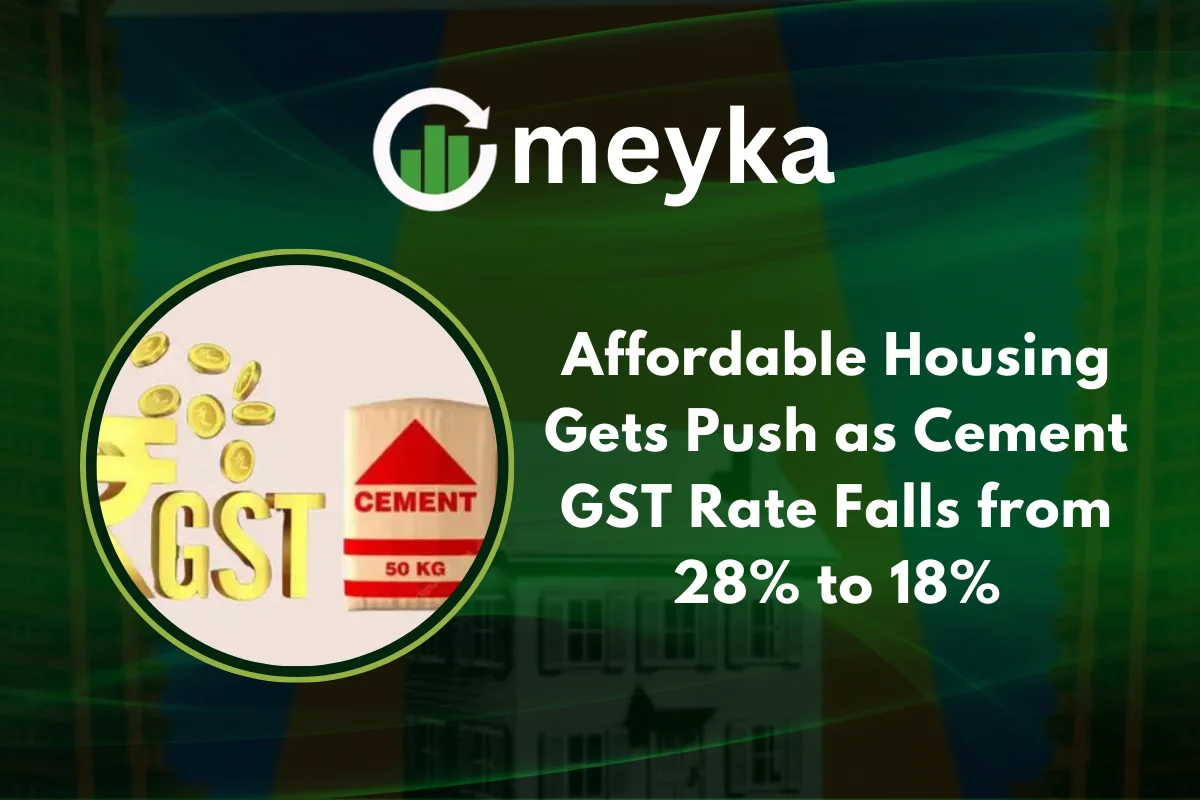Affordable Housing Gets Push as Cement GST Rate Falls from 28% to 18%
The cement GST rate has recently been reduced from 28% to 18%, marking a major development for India’s housing and infrastructure sector. This move lightens the burden on developers and strengthens the vision of making affordable housing accessible for millions of citizens.
Cement, being one of the most crucial materials in construction, plays a direct role in the overall cost of projects. With this reduction, the sector anticipates growth in housing supply, infrastructure development, and economic momentum.
Cement GST Rate Cut: A Game-Changer for the Housing Sector
Cement accounts for a large portion of construction expenses. Earlier, the 28% GST slab had been a long-standing concern for developers, contractors, and homebuyers, who argued that such a high tax rate pushed housing beyond affordability. The reduction to 18% is not just about lowering costs, it’s about enabling a chain reaction of positive impacts.
Lower costs in raw materials lead to more competitive pricing of homes, reduced construction costs, and stronger margins for developers. This ultimately helps in achieving the government’s “Housing for All” mission while supporting the Make in India and infrastructure growth agendas.
Impact on Affordable Housing Projects
Affordable housing projects, often targeted toward low- and middle-income families, are particularly sensitive to input costs. The GST cut on cement is expected to reduce construction costs, allowing developers to pass on the benefits to buyers.
Builders working under schemes such as the Pradhan Mantri Awas Yojana (PMAY) can now deliver homes at a lower price, potentially attracting more buyers. For end-users, this means reduced financial stress and easier access to housing loans. With the availability of cheaper homes, the dream of owning a house becomes more realistic for millions.
Boost to Infrastructure and Economic Growth
Cement is not limited to residential buildings; it is also the backbone of roads, bridges, schools, and hospitals. A lower cement GST rate provides a significant boost to infrastructure projects. With reduced costs, governments and private players can stretch budgets further, initiating more projects across rural and urban areas.
Stronger infrastructure directly contributes to economic growth by improving connectivity, reducing logistics costs, and creating job opportunities. The multiplier effect of this GST cut will therefore be felt across multiple sectors of the economy.
Developers and Industry Voices on GST Reduction
Industry experts and developers have consistently demanded a reduction in the cement GST slab. According to the Confederation of Real Estate Developers’ Associations of India (CREDAI), this decision will create balance in the construction supply chain.
Large developers believe that the cut will lead to higher project viability, especially in Tier-II and Tier-III cities, where demand for affordable homes is soaring. Smaller builders are also relieved as it reduces their dependence on costly loans, enabling them to deliver projects on time.
Stock Market and Cement Industry Response
The cement sector is one of the biggest beneficiaries of this GST revision. Shares of major cement companies like UltraTech Cement, Ambuja Cement, and Shree Cement saw increased investor interest after the announcement. Stock market analysts view this change as a positive catalyst for the industry, likely leading to higher production volumes and profitability.
In addition, the infrastructure push is expected to keep cement demand strong. For investors looking into AI stocks and stock market trends, cement companies now present a solid case for portfolio diversification. With stronger demand visibility and government-backed incentives, cement stocks are gaining traction in stock research circles.
Link to Government Housing Initiatives
The Indian government has consistently emphasized affordable housing and urban development through schemes like Smart Cities Mission and PMAY. By reducing the GST on cement, the government has aligned taxation with policy objectives.
This ensures that developers and policymakers work together to bridge the gap between demand and supply in the housing sector. It also reflects a more pragmatic approach to taxation, where revenue collection is balanced with long-term economic and social benefits.
Global Perspective on Construction Taxation
Globally, many countries keep construction materials in lower tax brackets to stimulate development. By aligning the cement GST rate closer to international practices, India is creating a competitive environment for its developers.
For instance, countries in Southeast Asia and the Middle East have long incentivized cheaper construction materials to fuel rapid urbanization. India’s decision reflects a similar strategy, aiming to strengthen competitiveness while improving domestic living standards.
Challenges Ahead Despite the Cut
While the GST cut is a welcome move, challenges remain. Land costs, regulatory hurdles, and delays in project approvals continue to be pain points for developers. Cement prices are also influenced by transportation and fuel costs, which can offset some of the GST benefits.
Therefore, experts suggest a holistic approach, where policies are aligned not just on taxation but also on ease of doing business, land reforms, and financial support for housing projects.
Way Forward for Developers and Buyers
For developers, the reduction provides room to scale up projects and deliver homes faster. For buyers, it translates into more choices and affordability. Banks and financial institutions may also benefit from rising loan demand as home ownership becomes more achievable.
The housing sector has always been a strong indicator of economic growth. With the GST cut, India can expect a renewed wave of investment, construction activity, and home ownership in the years to come.
FAQs
The reduction lowers construction costs, allowing developers to price homes more affordably, especially in the affordable housing segment.
Yes, cement companies are likely to see higher demand, increased sales volumes, and stronger profitability, boosting their stock performance as well.
Yes, it directly complements schemes like PMAY by making homes more affordable and encouraging developers to invest in low-cost housing.
Disclaimer:
This content is made for learning only. It is not meant to give financial advice. Always check the facts yourself. Financial decisions need detailed research.






